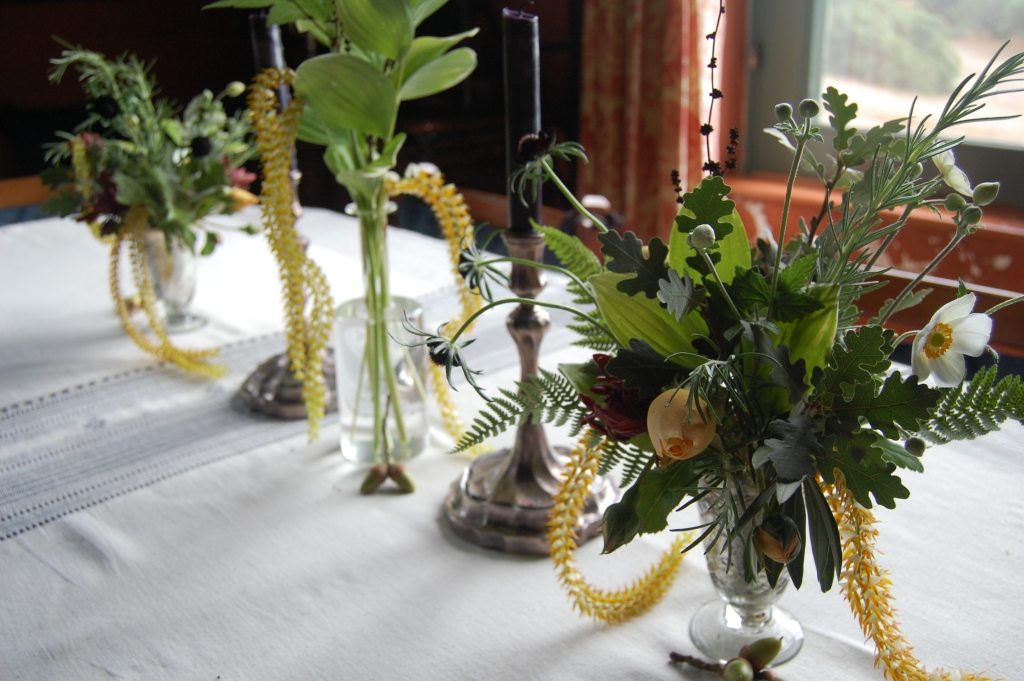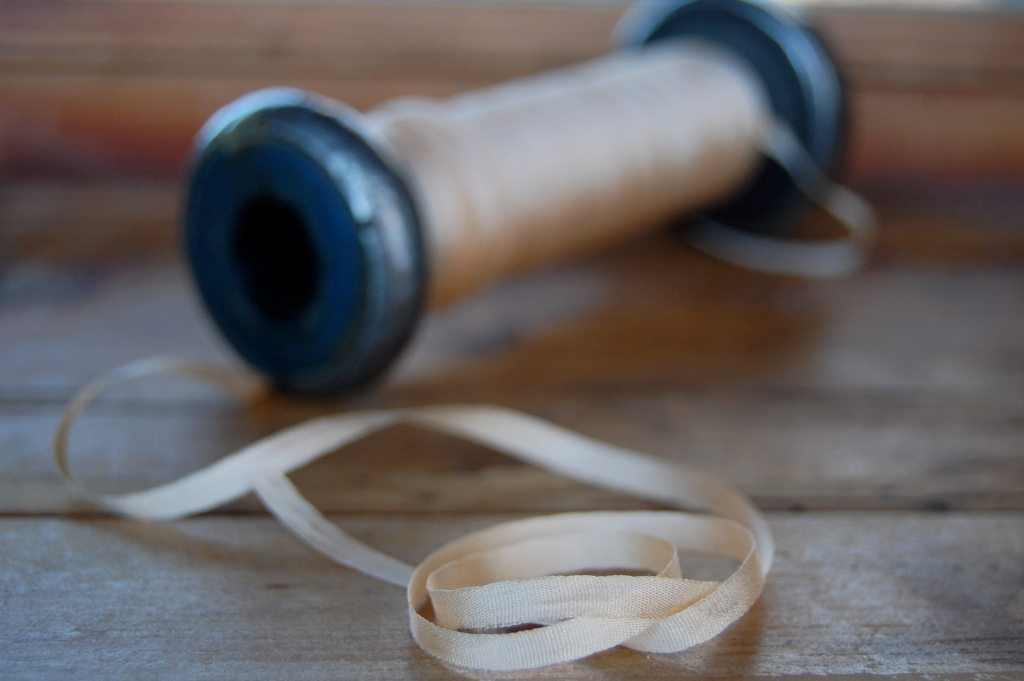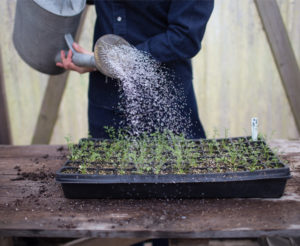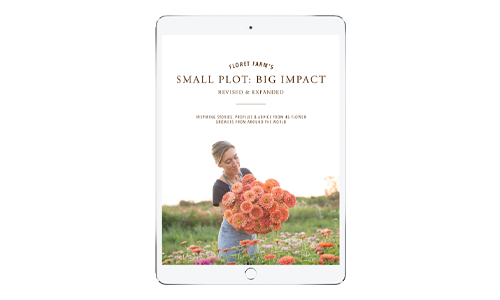 From the green energy that powers its website, to the fuel efficiency of its delivery vehicle, The Monkey Flower Group is a model of sustainability and sets the bar high for environmentally friendly florists. Owned and operated by Jaime Giorgi, The Monkey Flower Group creates and delivers gorgeous seasonal bouquets of locally-grown flowers to the San Francisco Bay Area and throughout Napa’s wine country. Floral designs from The Monkey Flower Group are coveted by eco-conscious couples and specialty shops including Dean & DeLuca. Jaime previously worked at a flower farm in Vermont and as a floral designer in Boston before returning home to Napa to starting her own eco-friendly floral design business. I asked Jaime to share a little more about her business, particularly her sustainable sourcing practices.
From the green energy that powers its website, to the fuel efficiency of its delivery vehicle, The Monkey Flower Group is a model of sustainability and sets the bar high for environmentally friendly florists. Owned and operated by Jaime Giorgi, The Monkey Flower Group creates and delivers gorgeous seasonal bouquets of locally-grown flowers to the San Francisco Bay Area and throughout Napa’s wine country. Floral designs from The Monkey Flower Group are coveted by eco-conscious couples and specialty shops including Dean & DeLuca. Jaime previously worked at a flower farm in Vermont and as a floral designer in Boston before returning home to Napa to starting her own eco-friendly floral design business. I asked Jaime to share a little more about her business, particularly her sustainable sourcing practices.
Erin: How does your previous experience working on a flower farm influence flowers you use or inform your purchasing decisions as a designer and small business owner?
Jaime: My role at Stray Cat Flower Farm was mostly design and business oriented, but the experience still reinforced what I already knew– commercial flower farming is incredibly difficult work! I also learned to appreciate more simple “common” flowers, especially statice, sunflowers, and snapdragons, which I was so used to seeing half dead and battered in coolers that I’d forgotten how sweet and beautiful they could be when grown and harvested with care. Health and freshness, not novelty, is what I look for in flowers now.
 Erin: Your company’s name refers to Mimulus, the plant genus that includes dozens of species of flowers, including monkey flower. Do you use a lot of monkey flower in your designs? I’ll admit, I’m not as familiar with it as I should be—what varieties are good cut flowers?
Erin: Your company’s name refers to Mimulus, the plant genus that includes dozens of species of flowers, including monkey flower. Do you use a lot of monkey flower in your designs? I’ll admit, I’m not as familiar with it as I should be—what varieties are good cut flowers?
Jaime: A lot of monkey flowers do hold up pretty well in water, but I usually think of them as a flower that’s best enjoyed on the plant. The main idea behind the name was to to suggest the local wild and cultivated components of my arrangements (like you said, Mimulus is a big genus, and it includes both fancy garden and scruffy wild flowers). Also, “Monkey” was my nickname as a kid, and the sticky monkey flower was always my special flower for me growing up. Maybe those weren’t the best reasons to take the name for my business, but it’s a good conversation starter, anyways, and gives me the chance to talk to people about the local focus of my materials.
 Erin: I do know that monkey flower is native to California (like you, right?). Do you use many native flowers in your designs?
Erin: I do know that monkey flower is native to California (like you, right?). Do you use many native flowers in your designs?
Jaime: I definitely have a preference for using plants that thrive here without much irrigation or inputs, so natives are a natural choice. Some of my favorite natives to use are coyote bush, bay, buckeye, manzanita, oak, wild grape, ferns (sword, polypody, and lady), and madrone.
Erin: Your commitment to environmental sustainability goes way beyond just buying local and discontinuing the use of floral foam. I really respect the fact that you are so conscious of the environmental implications of all aspects of your operation, including such things as supplies. I read on your website that you’ve stopped using polyester ribbon because it is, petroleum-based and non- recyclable. Can you tell me a little bit more about the natural ribbons you have found and use to wrap your gorgeous bouquets?
Jaime: When I got tired of picking bits of polyester ribbon out of my compost, all I wanted was a simple, versatile, discreet ribbon that was responsibly made and compostable. I still haven’t found a silver bullet, but I do have a few tools in my kit that are good working solutions for now.
First, local wool yarn is great and definitely something I wish I had more opportunities to use. It’s biodegradable, renewable, minimally processed, sustainably and locally grown, a little rustic and a little earthy, but just a bit more finished feeling than jute twine (which is my go to for all basic binding purposes). But it is not for all brides (or grooms).
 I had high hopes for conventional cotton ribbon, which is biodegradable, made from renewable raw materials, minimally processed, and available in lots of colors and widths. But it’s often too heavy for delicate work, and is made with input and irrigation-intensive raw materials, so I don’t like to use it.
I had high hopes for conventional cotton ribbon, which is biodegradable, made from renewable raw materials, minimally processed, and available in lots of colors and widths. But it’s often too heavy for delicate work, and is made with input and irrigation-intensive raw materials, so I don’t like to use it.
Organic cotton ribbon, on the other hand, has turned out to be a good option for me in many situations. It’s still too heavy for a lot of things, and doesn’t come in a lot of colors, but if those limitations aren’t problematic for a particular application, it’s my first choice.
When color and weight are an issue, though, I use rayon ribbon. It’s biodegradable, made from renewable raw materials, readily available from US manufacturers (ensuring certain levels of environmental and labor, and safety standards), available in lots of colors, as is light weight enough for flowing or delicate work. The decision to use rayon was a little difficult because most rayon manufacturing processes are not considered “green.” Still, the cellulose it is made from comes from sources such as beech, pine, eucalyptus, and bamboo that usually sequester more carbon, require fewer inputs, and less irrigation than conventional cotton.
 I also occasionally use natural silk embroidery ribbon. It’s not readily available from US manufacturers, is often heavily packaged, and is very sensitive to moisture discoloration. But it’s available in lots of colors and widths, so it’s what I go to when I need a very wide or very narrow light weight ribbon.
I also occasionally use natural silk embroidery ribbon. It’s not readily available from US manufacturers, is often heavily packaged, and is very sensitive to moisture discoloration. But it’s available in lots of colors and widths, so it’s what I go to when I need a very wide or very narrow light weight ribbon.
Some good sources for purchasing natural fiber ribbon online are Ribbon Connections (especially for organic cotton), Lawrence Schiff Silk Mill (especially for rayon and organic cotton), and Cam Creations (especially for silk).
Erin: What other environmental initiatives have you incorporated into your business model?
We recycle or compost almost all of our waste, but we’re always looking for ways to further reduce, whether by offering incentives for returning vases (with a deposit system), building with reclaimed materials (our new studio features 1920s era knotty pine removed from my sister’s house in a remodel), and talking events clients out of things they don’t need (and will likely be left behind and subsequently thrown out at the end of the night).
 Erin: Your mild Northern California climate and location near so many flower growers must mean you have a tremendous variety of flowers from which to choose. Just as you never want to be without bread or milk in your refrigerator, what are some of the flowers that you always want to have in your floral cooler?
Erin: Your mild Northern California climate and location near so many flower growers must mean you have a tremendous variety of flowers from which to choose. Just as you never want to be without bread or milk in your refrigerator, what are some of the flowers that you always want to have in your floral cooler?
Jaime: It’s true, we’re spoiled here. But I do still really love the simple stuff! I almost always have alstoemeria (especially more earthy, understated colors, like white with deep burgundy to brown spots), scabiosa (especially white), carnations (in the winter/spring), and football mums (in the summer/fall) on hand. Between those three things and whatever additional flowers and textures can be foraged from the garden and landscape, I feel pretty set.
Erin: I laughed out loud when I read one of your social media posts justifying going a bit overboard with a cutting of acacia because it is an invasive non-native plant. Too funny. I’d actually love to start a little campaign to popularize the, ahem, pruning of those pesky invasives—the pretty ones, of course! What do you think?
Jaime: It is a fun idea! It’s so tricky, though, too. There are actually very few non-natives that I actively try to eradicate (like velvet leaf and star thistle), mostly because I’ve noticed that the non-natives do at least provide habitat, pollinator forage, and bank stabilization that in the absence of a careful reintroduction of native vegetation seems better than nothing. I think that looking to your neighborhood for well-adapted and well-established greens and textures (that thrive without inputs or irrigation) is always a great way to both reflect the local landscape in your arrangements and reduce the carbon and water footprint of your materials. Some of my favorites non-natives are silver cotoneaster, acacia, Himalayan blackberry, privet, eucalyptus, teasel thistle, perennial sweet peas, and ivy.
 Erin: I’m so intrigued by the Flowers To Care program that you offer for folks outside your delivery area. Can you explain to my blog readers how that works?
Erin: I’m so intrigued by the Flowers To Care program that you offer for folks outside your delivery area. Can you explain to my blog readers how that works?
Jaime: Flowers to Care started out as an option for out of towners, but it’s just been a great way to spread the love with local flowers for everyone. Even Napans use the service now. Here’s how it works. When someone orders Flowers to Care, I design a small arrangement using whatever is local, fresh and beautiful, then send an email containing a link to a hidden web page where the purchaser can view and download a professionally shot digital photo of the flowers, and share it with as many people as they want by forwarding along the email. Meanwhile, the actual fresh flower arrangement is delivered to Cope Family Center, to be enjoyed by members of the community there. It’s a pretty great organization, and I always enjoy bringing them flowers!
Erin: Wow, that is totally awesome! What a great way to support local flower farmers and a great organization. Jaime, thank you so much for your commitment to buying locally and for your outstanding leadership as a green business.
Connect with The Monkey Flower Group:







Join the Conversation